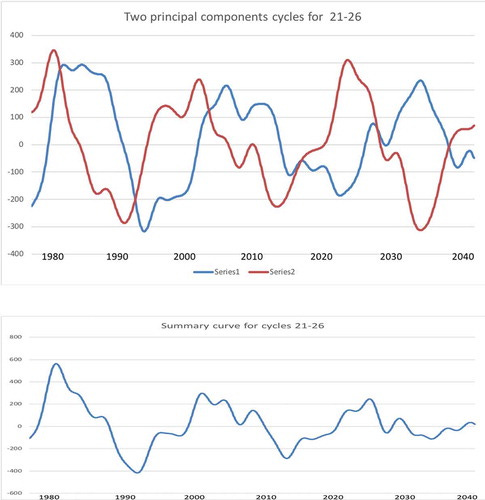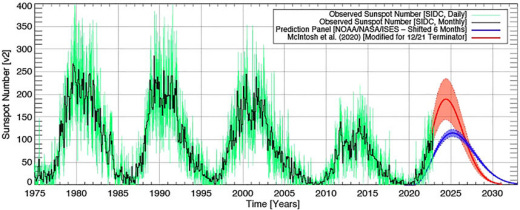Grand Solar Minimum Delayed Or Cancelled
It looks like reports of the imminent demise of solar activity and a possible new 'little ice age' were wrong.
I bought into the Grand Solar Minimum predictions, I must admit. I took very seriously Prof Valentina Zharkova’s prediction of a Grand Solar Minimum 2020-2053 based on the physics of a solar dynamo model with two out of phase principal component magnetic fields whose predictable wave-like interactions determine the strength of the solar background magnetic field and thus the amount of sunspot activity on the surface of the sun. Let’s face it, a new ‘Maunder Minimum’, which last time corresponded with the coolest 65 year period of the chilly Little Ice Age, would shut the global warming fanatics up once and for all, surely, and prove that the Sun was the main driver of climate on this planet, not man-made CO2. It was an alluring prospect to get these hysterical cult-members off our backs and stop them destroying western civilisation and technological progress with their ridiculous Medieval ‘renewable energy’ scams.
Zharkova’s two principle magnetic components are depicted here:
You can see that during the high solar activity in the 1980s and early into the 21st century, the two components were more in phase and reinforced one another. But then starting just before 2020, they start to go out of phase and cancel one another, leading to a weak SBMF and much reduced sunspot activity. The conclusion was that solar cycles 24-27 would be weak, getting progressively weaker through 25, then 26, where very few sunspots would occur, slowly recovering in solar cycle 27. The upshot would be a new Grand Solar Minimum lasting from 2020-2053. This is what the forthcoming grand solar minimum was supposed to look like:
Solar cycle 25 was supposed to be much weaker than 24. It hasn’t turned out that way though:
SC25 is currently trending above predictions (blue curve) and if the near term forecast of activity is correct (red curve), solar maximum will arrive early and peak even higher than SC24. It seems unlikely that SC26 will then be as weak as previously forecast by Zharkova and others, but we shouldn’t rule out the possibility. However, no grand solar minimum for the foreseeable future. The Sun does influence the climate here on earth, quite significantly, via a complex web of interactions involving not least the ENSO cycle (alternating tropical Pacific El Ninos and La Ninas), plus the Atlantic Multidecadal Oscillation (AMO), so if solar activity picks up again, we might see more warming. The rare ‘triple dip’ La Nina, which has seen temperatures in the Pacific cool significantly, is now ending and an El Nino is forecast this autumn/winter which, depending on its strength, will bump up global temperatures. So expect a climate alarmist feeding frenzy in the coming year. Shame, these pests will jump on any evidence of natural warming to claim the imminence of man-made Thermageddon, but a grand solar minimum wasn’t really good news anyway. The last one certainly wasn’t.
Addendum
Here is the latest sunspot numbers for SC25. As you can see, they are really picking up:
Source: https://www.solen.info/solar/








In a 2020 paper, Prof Zharkova was still predicting a drop in temperature of approximately 1C between 2020 and 2053. This would wipe out nearly all of the global warming (1.2C) which has occurred after 1850. I don't think this is going to happen given the progress of SC25.
"In this editorial, I have demonstrated that the recent progress with understanding a role of the solar background magnetic field in defining solar activity and with quantifying the observed magnitudes of magnetic field at different times allowed us to enable reliable long-term prediction of solar activity on a millennium timescale. This approach revealed a presence of not only 11-year solar cycles but also of grand solar cycles with duration of 350–400 years. We demonstrated that these grand cycles are formed by the interferences of two magnetic waves with close but not equal frequencies produced by the double solar dynamo action at different depths of the solar interior. These grand cycles are always separated by grand solar minima of Maunder minimum type, which regularly occurred in the past forming well-known Maunder, Wolf, Oort, Homeric, and other grand minima.
During these grand solar minima, there is a significant reduction of solar magnetic field and solar irradiance, which impose the reduction of terrestrial temperatures derived for these periods from the analysis of terrestrial biomass during the past 12,000 or more years. The most recent grand solar minimum occurred during Maunder Minimum (1645–1710), which led to reduction of solar irradiance by 0.22% from the modern one and a decrease of the average terrestrial temperature by 1.0–1.5°C.
This discovery of double dynamo action in the Sun brought us a timely warning about the upcoming grand solar minimum, when solar magnetic field and its magnetic activity will be reduced by 70%. This period has started in the Sun in 2020 and will last until 2053. During this modern grand minimum, one would expect to see a reduction of the average terrestrial temperature by up to 1.0°C, especially, during the periods of solar minima between the cycles 25–26 and 26–27, e.g. in the decade 2031–2043."
https://www.tandfonline.com/doi/full/10.1080/23328940.2020.1796243
Spaceweather.com reports today:
"Solar Maximum is coming--maybe this year. New research by a leading group of solar physicists predicts maximum sunspot activity in late 2023 or early 2024, a full year earlier than other forecasts."
"This is based on our work with the Termination Event," explains Scott McIntosh, lead author of a paper describing the prediction, published in the January 2023 edition of Frontiers in Astronomy and Space Sciences.
https://spaceweather.com/archive.php?view=1&day=12&month=04&year=2023
A few months back Finnish researcher Peikko, who some may know from Twitter, pointed out the polar fields were about to flip as they rapidly decayed. An early max is something I've had an inclination for due to the way SC25 has behaved which until quite recently has been quite anemic in terms of large sunspot groups (since changed). I have hypothesised the first peak will be the larger of the two. However, I have wondered why McIntosh have been given such credence as back in 2021 they stated:
“If the Terminator Event happens soon, as we expect, new Solar Cycle 25 could have a magnitude that rivals the top few since record-keeping began,” says McIntosh.
https://wp.me/pi4G5-dUc
Well actually I don't wonder as when these two came upon the scene it was seized upon by climate cultists to shout down the GSM crowd - which is hilarious because if it heats up globally with a big cycle we don't need the gas of life as an excuses, but hey ho.
The thing is SC25 is not a big cycle. Here is a comparison between some of the lowest solar cycles of the past 200 years (Maunder excluded) and whilst the amplitude is larger than SC24 it does sit nicely within the scope of the late 19thC/early 20thC solar cycles 12, 13, 14 & 16
http://solen.info/solar/images/comparison_similar_cycles.png
So no monster cycle and no pathetic cycle either.
I'll just watch and see how this goes. I'm not invested in any camp prophesying climate doom as the biggest threat we face are the absolute cretins spreading FUD and their zombified dead eyed souless acolytes demanding to be screwed even harder.